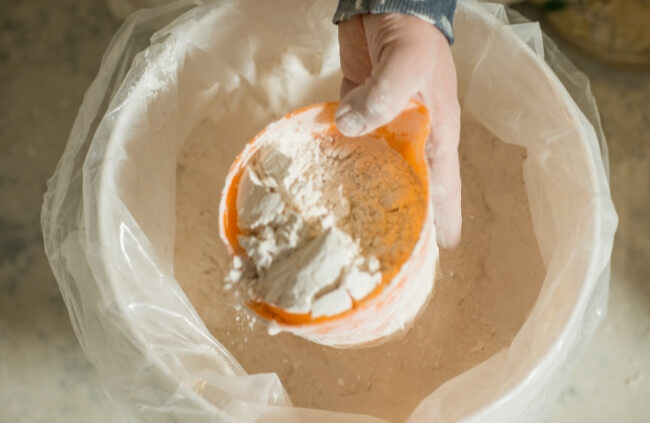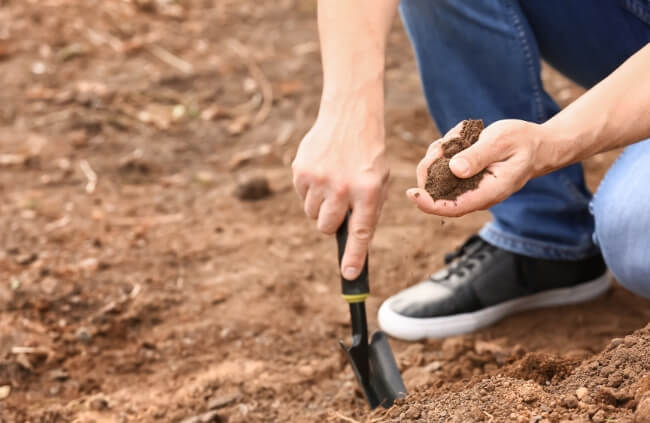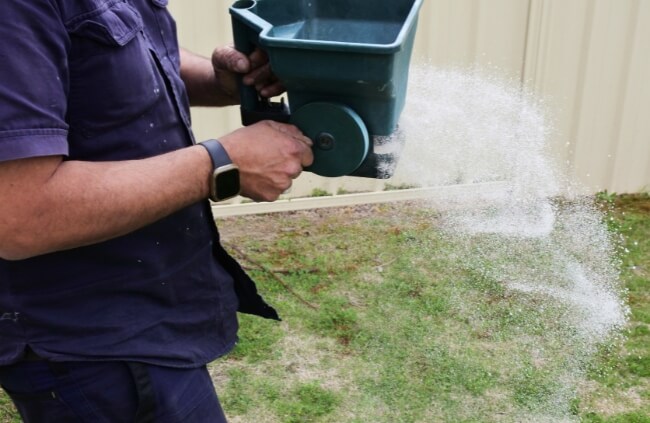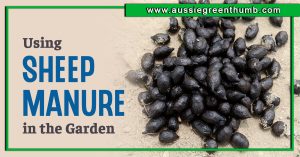The world soil improvers is big, and it’s full of bizarre contradictions, like how organic compost will both improve drainage on clay and improve water retention on the sand. But, there’s a saviour for your difficult clay soils, and it comes in the form of gypsum.
Adding gypsum to clay soil works into the structure of the clay to hold it apart, and open up its structure. This prevents both waterlogging and that horrible, cracker, dry clay we all know and hate.
In this guide, we’ll look at the science of why this works, and how to put it into action, plus some advice on how to source good quality gypsum, particularly for larger projects.
More...
What is Gypsum?

Gypsum is a naturally occurring soft sulphate. Specifically calcium sulphate dihydrate. In its hydrated form, it is a powder used most commonly around the world to make wall plaster in the building trade.
In horticulture and agriculture, gypsum is an incredibly useful soil adjustment, offering essential minerals in the form of calcium, and making other pre-existing minerals in the soil more accessible by opening up soil structure.
When do you need to add gypsum to your garden?
Gypsum is not a stand-alone fertiliser, and should always be used in conjunction with mineral and nitrogen-rich soils, or with the addition of other organic fertilisers like manures or organic composts.
If your soil cracks in summer and turns sodden in winter, it’s the clearest indication of clay soil, but a simple test you can do yourself is you dig down to about 2 ft deep.
If any layer of soil in that hole comes out in a form that can be squeezed into a ball that doesn’t crumble, it’s going to make it much harder to grow many types of plants – particularly native ornamentals which like good drainage.
Some nutrient deficiencies may also occur in these conditions as the denser soil structure makes it much harder for roots to establish, and the smaller fibrous parts of roots fail to process nutrients.
Part of this problem is the result of inaccessible acidity. Holding water in poor clay soils means that even a soil that is slightly acidic (the ideal conditions for most natives) doesn’t have that effect on growing plants.
By adding gypsum, and opening up the soil structure, the natural acidity is unaffected (unlike adding lime) and plants suddenly have access to both essential nutrients (nitrogen, phosphorus, and potassium) and minerals like magnesium and zinc that are already existing in the soil.
What does gypsum do to soil?
Gypsum does not, despite several reports to the contrary, change the pH of soil. It is a neutral soil additive that prevents dry clay soils from drying out. By opening up the structure of clay, it means water can be taken up faster and held in place when it rains.
Gypsum also has effects on nutrient uptake and some toxic minerals that may be present, particularly on long-standing agricultural land.
Gypsums effects on soils structure
Usable soil has open pores between mixed particulates of composted natural matter, grains of rock, and loose minerals. Clay is primarily a micaceous structure, meaning its flake-like particles sit flat against one another, leading to a much denser soil that holds in tight clumps and fundamentally, allows water to flow over before soaking.
Gypsum opens up these tight gaps between micaceous clay particles, allowing air to flow, and water to be both retained and drained through the gaps.
One common misconception is that clay is a damp soil when for most of Australia it is more often dry and requires exceptionally heavy rainfall to soak back to a usable structure. Gypsum speeds up this process, retaining moisture, and allowing adequate drainage on dry clay. It has very little effect on damp clay.
Gypsum’s effect on soil nutrients
If growing tomatoes, and finding blossom end rot is a problem, gypsum can be a useful tool to quickly add calcium back into the soil. Its most useful application though is as a pre-treatment to soil before planting.
Gypsum adds no nutrients other than calcium to soil, but by making dry clay more accessible, will give plants better access to nutrients when they root. Phosphorus in particular is easier to manage, with better retention reported on clay soils treated with gypsum.
Gypsum’s effect on soil pH
Gypsum is often confused with lime. Lime is commonly used to make acidic soil more alkaline. Gypsum does not affect soil pH. Slightly acidic soil will remain slightly acidic, and highly acidic clay soil will gently reduce acidity as a result of better structure, but not as a direct result of gypsum application.
Using Gypsum to Improve Clay Soil
So, we know what gypsum does to soil, but how do you put it into action? Well, it’s actually pretty simple. Unlike Lime, which can quickly be over-applied, gypsum is generally easier to use, and easier to calculate.
A bit too much, or a bit too little, and you won’t see any problems, provided you stick to the guide below.

Testing soil to see if it needs gypsum adding
If you’ve got dry clay soil that stays cracked even after rain, then gypsum isn’t going to do any harm, and it’ll probably be the saviour you need to get gardening properly again. The key test for clay soils, where gypsum is going to be useful, is super simple, and very DIY friendly. All you need is a glass of water and a handful of soil.
Pop about two tablespoons of soil into the water, and stir it well. If it doesn’t settle after ten minutes, or the water remains very cloudy, with a little bit of settled sediment, gypsum will help your soil structure. The other major point where gypsum will help is on calcium-deficient soils.
To test for calcium, you can buy a soil testing kit, or use a simple vinegar test. Drop white vinegar onto a small soil sample. If it fizzes, you’ve got calcium present, if it fizzes a lot, you’ve got a lot of calcium present. If it doesn’t fizz at all, gypsum will help add accessible calcium without changing the pH.
Preparing the soil before adding gypsum
There is no preparation needed prior to the application of gypsum. Working it in is done once you’ve calculated amounts and applied gypsum to the surface.
How much gypsum to apply
Depending on the depth and severity of the clay soil, different application amounts are required. If the surface soil (top 15 cm) is clay, but the subsoil is a draining sediment, loam, or rock, then apply gypsum to clay soils at a rate of about 1 kg per square metre.
If the clay is problematic down to 1 foot (30 cm), then apply 1.5 kg to the surface.
How to Apply Gypsum to Clay Soil
Apply gypsum to the surface of your soil. Once evenly applied, dig over small areas with a fork, medium-sized areas with a powered rotator, and larger spaces with agricultural tools like tillers and cultivators.
It will take a couple of weeks to fully affect the soil structure, and on very heavy clay may require a second application.
Once the desired soil structure is achieved, add organic materials to replace nutrients, and help to retain moisture in more accessible forms. This can be done with slurries, rotted manures, composted seaweed, or garden compost.
Apply any organic fertilisers liberally in the first instances and dig them right through the area again.
When to Apply Gypsum to Clay Soil

Apply gypsum at any time of year, either as a topical treatment for calcium deficiency, which is watered into the soil or as a pre-treatment for clay soils by deep cultivation.
Because the process of applying gypsum and fertiliser to clay soils can take several weeks, it’s worth planning this well before you start planting or sowing seeds.
Does gypsum improve sandy soil?
When applied to sandy soils, gypsum can suppress phosphorus uptake, and potentially cause problems for plants. The only time where gypsum is useful on sandy soils is to counteract alts in the case that your soil develops a white film in summer.
Gypsum does very little to the structure of sandy soils, and nothing to the pH so avoid it unless you are amending calcium during the growing season (use limited amounts) or fixing salinity.
Is Gypsum Good for Native Plants?
OK, so this bit is where the science gets a bit confusing, but the short version is that yes, gypsum is good for most native plants, even those with phosphorus sensitivities.
Phosphorus sensitivity and phosphorous toxicity in native Australian plants can lead to blacked leaves, dropped flowers, and failed fruit. This occurs when soils stop holding phosphorus, which is present in nearly all soils.
Plants take phosphorus when it is in solution with water, which occurs on clay soils as the soil allows it to become accessible. By adding gypsum, the phosphorus is locked back into the soil in its solid state, and therefore not accessible to plants.
There are hundreds of research papers on this that go into more detail, but if you ever notice blacked, burned-looking sections of your native plants on clay soil, particularly in winter, when clay soils release phosphorus in a soluble form, then adding gypsum can really, really help.
What native plants are happy in clay soils?
Not all Australian plants need gypsum adding, and if you want to save yourself time, money, and effort, there are some great natives that grow perfectly well on clay soil without any amendment with gypsum or other additives.
Native shrubs for clay soil
Most species of Banksia and Grevillea will grow on dry clay in most of Australia without fuss for high-impact, large shrubs on clay soil.
For smaller shrubs and border fillers, try Callistemon or Westringia which will both grow well, but will also need some extra watering for the first couple of years while they establish. Once established, they’ll be fine on dry clay even through drought.
Tea trees (Leptospermum) will grow happily on clay soil provided it isn’t too dry or too wet, so in milder parts of the country, it’s a good choice.
Native trees for clay soils
Larger varieties of Myrtle will grow on clay soils, and Acacia can cope with any conditions you throw at it, provided it’s not overly damp in winter. Both are reasonably fast growing too, so once they’ve established roots, they can grab moisture where they need it, and will both flower beautifully too.
Native climbers for clay soils
If you keep them well watered and add plenty of organic matter like rotted manure in spring, climbing roses will do well on a base of clay soil, but if you prefer to do as little as possible, try native Pandorea jasminoides, which will grow pretty much anywhere provided it’s protected from frost.
Native perennials for clay soils
There are so many herbaceous plants that work on clay soil that it’s hard to choose just a few, but Brachyscome and native violets work really quite well in gardens. Some low-growing Grevilleas offer easy structure too in these challenging conditions.
Native grasses for clay soils
Blue Fescue and Club rush grow on wet and dry clay, offering year-round structure, particularly in summer when they’re at their flowing best.
Where to buy gypsum for gardens in Australia

Most garden centres and farm supply shops will have gypsum in stock in spring, and it’s usually available from bigger chain stores like Bunnings which sell gypsum all year round.
For bulk purchases check out agricultural suppliers or even direct from the gypsum mines dotted all over WA, NSW, QLD, and SA.
Frequently Asked Questions About Gypsum
Can you use gypsum plaster for gardens?
You cannot use gypsum plaster in the garden. Gypsum that is suitable for horticultural and agricultural use is straight gypsum. Gypsum plaster has additives that form hardness. It will not help the soil in any way.
How long does gypsum take to break down clay soil?
Gypsum will start working on clay soils straight away. Once dug through it will help to retain moisture, and prevent clay soil from drying out, but it will take about two months to take full effect and truly alter the soil structure.
What happens if you apply too much gypsum to clay soil?
Adding too much gypsum really would mean excessively liberal application, but if you do somehow really, really overdo it, gypsum can cause essential elements like iron and magnesium to flow away from the soil, leading to less mineral content, and weaker plants.
How do you use gypsum on a lawn?
To add gypsum to your lawn, you simply need to sprinkle it over, either by hand or using a fertiliser spreader for more even applications. Leave it to work in with rain, and it will help to slowly improve soil structure.
Can you apply gypsum and fertiliser at the same time?
Gypsum and fertiliser can be applied at the same time, but it’s best to apply gypsum first, particularly for open spaces, and work it in. Leave it to work for a few weeks so you’ve got a better idea of how much, and what type of fertiliser to add.
Does gypsum add nitrogen to soil?
Gypsum does not add Nitrogen to soil, but by fixing soil structures, gypsum reduces nitrogen-fixing, meaning there is more soluble nitrogen available to plant roots.
Does gypsum neutralise dog urine on lawns?
Gypsum can be sprinkled directly onto dog urine patches while wet to neutralise the ammonia and helps to prevent urine burn on your lawns.
Wrapping Up Our Guide to Using Gypsum
Gypsum is a wonderful tool in gardens and is very much underutilised. A single application can be the difference from a limited stock of plants to a whole world of potential flora to choose from. If you’re stuck with clay soil, whether on large-scale projects, or domestic gardens, gypsum will likely offer some sort of lifeline.
Do make sure to check the type of clay, and the state of clay too though, as gypsum is best used on dry clays, to help them retain water, and balance the available nutrients.
Published on August 21, 2023 by Gary Clarke
Last Updated on October 25, 2023





Thankyou, that was the clearest most concise explanation reguarding the use of gypsum I have read thumbs.